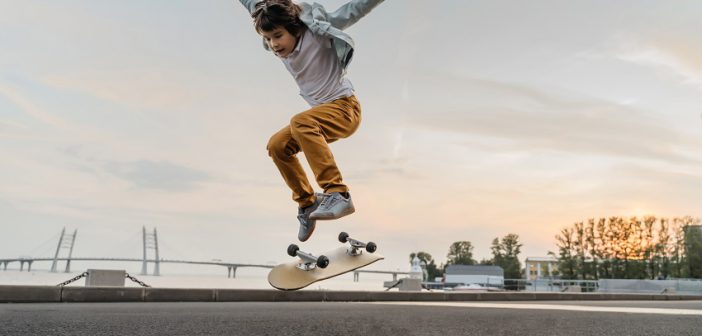Skateboarding is among the best physical activities suitable for kids. It’ll keep your kid entertained, help them develop motor skills, balance, and coordination, as well as improve their overall physical and mental health.
It’ll also help them develop a growth mindset. They’ll realize that practice will help them improve and that failure is part of the learning process. When they fall, they can get back up and try again. No matter what challenges they face, they’ll have the courage and strength to overcome them.
Though skateboarding seems like a dangerous sport for your kid, it’s an exciting activity they’ll enjoy. It’ll mold them to be a well-rounded individual who knows how to work and communicate well with others. It’ll even instill confidence in themselves.
If you want to introduce your kid to skateboarding, keep reading this guide.
- Enroll In Lessons
It’s important that your child learns from a certified instructor. You can search for a qualified trainer who offers skateboarding lessons near you and can accommodate your schedule.
In-person lessons provide the best experience for a beginner. Your kid will learn the basics of turning, pushing, pumping on transitions, and carving transitions. Moreover, they’ll be taught how to do frontside and backside kick turns, position their body and feet, and drop in on banks. They’ll be introduced to some tricks as well, such as ground and basic ramp tricks.
Aside from enrolling your kid in skateboarding lessons, you can help them master the basics. The first thing you can help them improve is balance. Ensure that their feet are resting on top of the bolts and that their head lies between their feet since their body will serve as their balancing tool. You can practice balancing with them on the grass until they’ve gotten the hang of it.
Once your kid feels confident, try balancing on the pavement with them. But be sure to support them. As your kid gets better at balancing, have them switch their feet and see to it that they’re comfortable on both sides.
The next lesson you can help them improve is pushing. This can be done by using the back foot and pointing the front one forward, with the tips touching the bolts. While pushing, they’ll need to get their back foot back on the board with a little hop.
- Choose The Right Type Of Skateboard
The size and type of skateboard depend on the age and height of the child. If you want a classic style, you should go with cruisers or mini-cruises that are suitable for kids aged nine and above. This type is lightweight, short in length, maneuverable, and easy to carry. In addition, it has wheels that are soft and roll easily, making it great for a beginner.
Skateboards that are ideal for skateparks and younger and older kids are double kick ones. You should also consider their key features, as these will affect the learning process.
One feature to look for is the board material. It needs to be durable and fit for first-time learners. For instance, wood is a classic choice that has evolved into a long-lasting multi-layer wood deck.
The board width is another important feature that you need to take into account. It should be based on the child’s height. For example, if your kid is 3 feet and 4 inches tall, the board should be between 6.5 and 7 inches wide.
- Invest In Protective Gear
A beginner is more likely to sustain injuries while learning how to skateboard, such as bruises, sprains, and fractures. Hence, providing your child with quality protective gear is crucial.
One key gear is a multi-sport helmet made specifically for skateboarding. It shouldn’t be too tight or too loose on your child’s head. To tell whether it’s the right fit, ask your kid to shake their head. If the helmet moves when your they shake their head, then it isn’t the right one.
Ideally, a skate helmet should be positioned low on the forehead and equipped with side straps shaped like a ‘V’ around each ear. It should feature a buckle that’s locked tightly under the chin. To check its tightness, have your kid slide two fingers between the strap and chin. If they aren’t able to slip their fingers in, then it’s tight enough.
Additionally, you’ll need to get a wrist guard and knee and elbow pads. Wrist guards aren’t necessary for an experienced skateboarder, but they are for a beginner who tends to land on their hands more than their knees when they fall. They lower the risk of your kid breaking or twisting their wrist.
On the other hand, knee and elbow pads can help prevent injuries, like bruises and cuts, or make them less severe when your kid falls. Knee pads are particularly useful during a knee slide maneuver.
Lastly, invest in closed-toe shoes that have slip-resistant rubber soles. They should have thick midsoles and padded tongues too, which will protect your kid’s ankles from obstacles and spinning boards.
Bottom Line
Skateboarding seems like a risky recreation for a child to pursue, but it’s actually a fun and an enriching activity that will teach them valuable lessons, such as perseverance and hard work. And with the skills they develop and insights they gain, they’ll become more creative, efficient, and confident in themselves.




